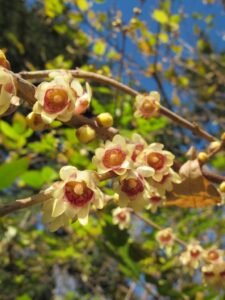
Winter’s sweet (Chimonanthus praecox) is a deciduous shrub known for its fragrant, pale yellow to deep yellow flowers that bloom in winter, often when snow is on the ground. This winter-blooming plant has a distinctive, sweet fragrance that is reminiscent of honey or a blend of citrus and allspice. The flowers themselves are waxy and delicate, with an attractive, almost transparent quality that makes them stand out in the cold winter months.
The plant is native to China and has been cultivated for centuries, both for its ornamental qualities and its scent. In some cultures, wintersweet is associated with resilience and the ability to thrive despite harsh conditions, as it blooms in the midst of winter’s chill. Some people also appreciate its use in traditional Chinese medicine, where it’s thought to have mild tonic properties.
Though not an overly large shrub, it can grow up to 10 feet tall and is often used in gardens for its unique timing of blooming. It does best in full sun to partial shade and well-drained soil, and it’s relatively hardy to colder climates, adding a splash of color and fragrance when most other plants are dormant. It can be a striking addition to a winter landscape, providing both visual and aromatic interest.
During the latter part of winter when day time temperatures start to rise, bees love wintersweet, so utilizing as a pollinator would be a great idea.
Wintersweet, although not the most utilized of plants, is a welcome addition and reminder of the promise of spring. (too cheesy?)
The top 2 cultivars in terms of their availability and popularity:
Chimonanthus praecox ‘Luteus’: This variety also only differs from the wild type in its flowers. ‘Luteus’ flowers are a particularly intense yellow.
Chimonanthus praecox ‘Grandiflorus’: As the name suggests, this variety is characterised by particularly large flowers. In terms of growth and winter hardiness, however, the ‘Grandiflorus’ is comparable to the wild form of Chimonanthus praecox.
